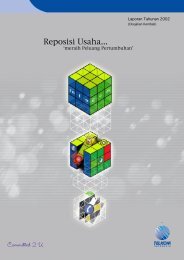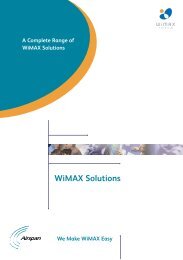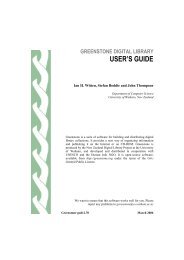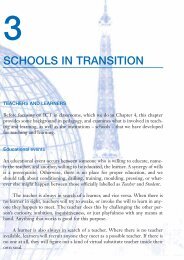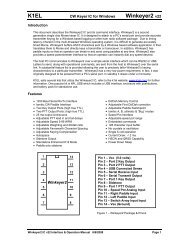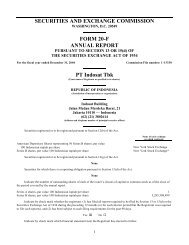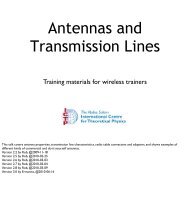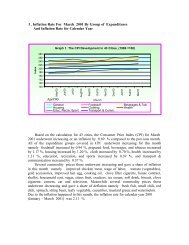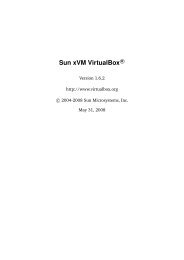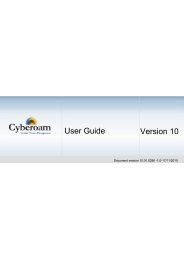Link Budget Calculation
Link Budget Calculation
Link Budget Calculation
Create successful ePaper yourself
Turn your PDF publications into a flip-book with our unique Google optimized e-Paper software.
<strong>Link</strong> <strong>Budget</strong><br />
<strong>Calculation</strong><br />
Marco Zennaro and Carlo Fonda<br />
the Abdus Salam International<br />
Centre for Theoretical Physics<br />
mzennaro@ictp.it
<strong>Link</strong> Planning<br />
•How far can we go?<br />
•How much power can we use?<br />
•What kind of antennas should be use?<br />
•Are all the cables the same?
dB math<br />
• decibels are a relative measurement unit unlike the absolute<br />
measurement of milliwatts<br />
• the decibel (dB) is an expression of the relationship between a<br />
variable quantity and a known reference quantity<br />
• the calculation of decibels uses a logarithm to allow very large or<br />
very small relations to be represented with a conveniently small<br />
number<br />
• on the logarithmic scale, the reference cannot be zero because<br />
the log of zero does not exist!
dB math<br />
• the reference point that relates the logarithmic<br />
dB scale to the linear watt scale is:<br />
1 mW = 0 dBm<br />
• the m in dBm refers to the fact that the<br />
reference is 1 mW and therefore a dBm<br />
measurement is a measurement of absolute<br />
power
dB math<br />
•to convert mW to dBm:<br />
P(dBm)= 10 log P(mW)<br />
•to convert dBm to mW:<br />
P(mW)= log-1 (P(dBm)/10)<br />
•gains and losses are ADDITIVE
dB math<br />
•gain or loss in an RF system may be referred to by<br />
absolute power measurement (10W of power) or by<br />
a relative power measurement (half of its power)<br />
•-3dB = half the power in mW<br />
•+3dB = double the power in mW<br />
•-10dB = one tenth the power in mW<br />
•+10dB = ten times the power in mW
dB math<br />
• 10 mW + 3 dB = 20 mW<br />
• 100 mW - 3dB = 50 mW<br />
• 10 mW + 10 dB = 100 mW<br />
• 300 mW - 10 dB = 30 mW
dB math<br />
!<br />
:6&(&!'7)&(!12))!4))#1!4!;723#1&'!)&%&)(!16&$!?2%&$!>#1&'!<br />
)&%&)(+!?42$(+!4$/!)#((&(!2$!/0=!4$/!/0@!!A2?7'&!B@-C!(6#1(!5645!56&!'&8&'&$3&!>#2$5!2(!<br />
4)14*(!56&!(4=&+!D75!>#1&'!)&%&)(!34$!=#%&!2$!&256&'!/2'&352#$!8'#=!56&!'&8&'&$3&!>#2$5!<br />
/&>&$/2$?!#$!16&56&'!56&*!'&>'&(&$5!4!>#1&'!?42$!#'!)#((@!<br />
!<br />
(")*+," '(!1'?'1!@#$(&"<br />
!<br />
!<br />
;A5<br />
/80<br />
;:5<br />
/80<br />
;)5<br />
/80<br />
;45<br />
/80<br />
5<br />
/80<br />
745<br />
/80<br />
7)5<br />
/80<br />
7:5<br />
/80<br />
7A5<br />
/80<br />
455<br />
.6<br />
4<br />
-6<br />
45<br />
-6<br />
455<br />
-6<br />
4<br />
06<br />
45<br />
06<br />
455<br />
06<br />
4B555<br />
06<br />
45B555<br />
06<br />
;4)<br />
/80<br />
;C<br />
/80<br />
;D<br />
/80<br />
;:<br />
/80<br />
;5<br />
/80<br />
7:<br />
/80<br />
7D<br />
/80<br />
7C<br />
/80<br />
74)<br />
/80<br />
D)EF<br />
-6<br />
4)F<br />
-6<br />
)F5<br />
-6<br />
F55<br />
-6<br />
4<br />
06<br />
)<br />
06<br />
A<br />
06<br />
G<br />
06<br />
4D<br />
06 !<br />
!<br />
E$!56&!5#>!364'5!#8!A2?7'&!B@-C+!?42$(!4$/!)#((&(!#8!-.!/0!4'&!(6#1$!45!&436!2$3'&=&$5@!!<br />
F#523&!5645!4!?42$!#8!G-.!/0!8'#=!56&!'&8&'&$3&!>#2$5!#8!-!=H!=#%&(!56&!>#1&'!5#!G-.!<br />
/0=!I-.!=HJ@!!"#$%&'(&)*+!$#523&!5645!4!)#((!#8!,-.!/0!=#%&(!56&!>#1&'!5#!,-.!/0=!<br />
I-..!=23'#1455(J@!!K$!56&!D#55#=!364'5+!56&!(4=&!>'2$32>4)!4>>)2&(@!!:6&(&!364'5(!D#56!<br />
'&>'&(&$5!56&!(4=&!562$?+!&L3&>5!5645!#$&!2(!2$3'&=&$5&/!2$!?42$(!4$/!)#((&(!#8!M!/0!4$/!<br />
56&!#56&'!8#'!?42$(!4$/!)#((&(!#8!-.!/0@!!:6&*!64%&!D&&$!(&>4'45&/!2$5#!51#!364'5(!8#'!<br />
&4(&!#8!%2&12$?@!!N(2$?!56&(&!364'5(+!#$&!34$!&4(2)*!3#$%&'5!/0=!4$/!=H!>#1&'!)&%&)(@!
dB math<br />
•+43 dBm<br />
•43dB = 10dB + 10dB + 10dB + 10dB + 3dB<br />
•1 mW x 10 = 100 mW<br />
•100 mW x 10 = 1000 mW<br />
•1000 mW x 10 = 10000 mW<br />
•10000 mW x 2 = 20000 mW = 20 W
dB math<br />
•-26 dBm<br />
•-26dB = - 10dB - 10dB - 3dB - 3dB<br />
•1 mW / 10 = 100 uW<br />
•100 uW / 10 = 10 uW<br />
•10 uW / 2 = 5 uW<br />
•5 uW / 2 = 2.5 uW
dB math<br />
•when quantifying the gain of an antenna, the<br />
decibel units are represented by dBi<br />
•the i stands for isotropic, which means that the<br />
change in power is referenced against an isotropic<br />
radiator<br />
•an isotropic radiator is a theoretical ideal<br />
transmitter that produces an e.m. field in all<br />
directions with equal intensity at a 100% efficiency
antenna gain<br />
•an antenna element is a passive device<br />
•the antenna can create the effect of<br />
amplification by virtue of its physical shape<br />
•by intentional radiator we mean the RF device<br />
and all cabling and connectors up to, but not<br />
including, the antenna
+%&'%&*,%(-#.(/*(&,0#<br />
!<br />
"2!3&0+#&3!;4!%,&!=&3&1$'!K-((.#+5$%+-#!K-((+22+-#!G=KKH:!$#!+#%&#%+-#$'!1$3+$%-1!+2!<br />
$#!
intentional radiator<br />
•any reference to “power output of the<br />
Intentional Radiator” refers to the power<br />
output at the end of the last cable or connector<br />
before the antenna<br />
•if a 30 mW transmitter loses 15 mW of power in<br />
the cables and another 5 mW from the<br />
connectors, the power of the intentional<br />
radiator is 10 mW
intentional<br />
!<br />
radiator<br />
! "#$%&'(!)!*!+,!,-./$0'.&$12!!!!"#<br />
$%&'()#*+,"# 3$0%1'!45('1'22!678!9:.;5:5.&!7 >:5.&!?<br />
9$=1'<br />
>:5.&!"<br />
9$=1'<br />
9:..'9&:(<br />
9:..'9&:(<br />
$.&'..$<br />
>:5.&!@<br />
!<br />
!<br />
!<br />
! ! ! -../00#12345## 12345#-###12345#6###12345#7###12345#8#<br />
ABB!0C! ! DE!/?! !!!!!DE!/?!!!!!!!DE!/?! FA)!/?5!<br />
G! ABB!0C! ! !)! !!!!!!)! !!!!!!!!!!)! HI)!I)!I)!I)J!<br />
G! ABB!0C! ! !)!!!!!!!!!!!!!!)! !!!!!!!!!!)! IAK!<br />
G! LB!0C! ! ! !!!!!!)! !!!!!!!!!!)! IAK!<br />
G! )L!0C! ! ! ! !!!!!!!!!!)! IAK!<br />
G! A)ML!0C! ! ! ! ! ! IAK!<br />
G! )BB!0C!<br />
!!!!!!!<br />
-..9:;5/#
EIRP<br />
•the EIRP is the Equivalent Isotropically Radiated<br />
Power<br />
•EIRP is the power actually radiated by the antenna<br />
element and is important because<br />
•it is regulated by the FCC or other regulatory<br />
agency<br />
•it is used in calculating whether or not a wireless<br />
link is viable
EIRP<br />
,"(1"(&)%&5$'%"!$/6&0,2&5"70&1,2$!&)%&'##,2$/6&'*/&0,2&(,&7'#7"#'($&(0$%$&8'#"$%&'!$&'##&<br />
7,8$!$/&)*&(0)%&9,,:3&&;'!(&@A&&)%&BGGG&5O6&,!&B&<br />
O'((3&&J0$&;
EIRP<br />
• suppose a transmitting station uses a 10 dBi antenna<br />
(which amplifies the signal 10 times) and is fed by 100<br />
mW from the intentional radiator<br />
• the EIRP is 1000 mW or 1 W<br />
• the FCC has rules defining both the power output at<br />
the intentional radiator and the antenna element
EIRP<br />
•the FCC enforces certain rules regarding the<br />
power radiated by the antenna element,<br />
depending on whether the implementation is<br />
point-to-multipoint or point-to-point<br />
•PtMP links are typically configured in a star<br />
topology<br />
•when an omnidirectional antenna is used, the<br />
FCC automatically considers the link a PtMP<br />
link
PtMP<br />
•in the setup of a PtMP link, the FCC limits<br />
the EIRP to 4 Watts<br />
•the power limit set for the intentional<br />
radiator is 1 Watt<br />
•is the transmitting LAN devices are<br />
adjustable with respect to their output<br />
power, then the system can customized to<br />
the needs of the user
PtMP<br />
•suppose a radio transmitting at 1 Watt(+30 dBm)<br />
is connected directly to a 12 dBi omnidirectional<br />
antenna<br />
•the total output power at the antenna is about 16<br />
Watts, which is well above the 4 Watts limit<br />
•the FCC stipulates that for each 3dBi above the<br />
antenna’s initial 6dBi of gain, the power of the<br />
intentional radiator must be reduced by 3dB below<br />
the initial +30dBm
PtMP<br />
•for our example, since the antenna gain is 12dBi,<br />
the power of the intentional radiator must be<br />
reduced by 6dB<br />
•this reduction will result in an intentional radiator<br />
power of 24 dBm, or 36 dM of EIRP which is 4<br />
Watts<br />
•the end result is that the power at the intentional<br />
radiator must never be more than 1 Watt, and the<br />
EIRP must never be above 4 Watts for a PtMP<br />
connection
PtMP<br />
&0/%00&12$,0,/,&3$4$*+,$"!$5&,06$/(%$7"8%#$&/$/(%$,0/%0/,"0&3$#&*,&/"#$9:2/$-%$#%*:'%*$-;$)$<br />
*+$-%3"8$/(%$,0,/,&3$
PtP<br />
•Ptp links include a single directional transmitting<br />
antenna and a single directional receiving antenna<br />
•the FCC mandates that for every 3 dBi above the<br />
initial 6 dBi of antenna gain, the power at the<br />
intentional radiator must be reduced by 1 dB from<br />
the initial +30 dBm<br />
•consider the previous example: 1W (+30 dBm) at<br />
the intentional radiator and a 12 dBi antenna<br />
(directional antenna in this case)
PtP<br />
•the total output power is still 16 Watts<br />
•since the antenna gain is 12 dBi, the power at the<br />
intentional radiator must be reduced by 2 dB<br />
•this reduction will result in an intentional radiator<br />
power of 28 dBm (30-2), and an EIRP of 40 dBm or<br />
10 Watts<br />
•in the case of PtP links, the power of the<br />
intentional radiator is still limited to 1 Watt, but<br />
the limit of the EIRP increases with the gain of<br />
the antenna
PtP<br />
"#$%!$&!'(!)*$+!,-.!/01.2!#,!,-.!$%,.%,$0%#3!2#)$#,02!45&,!6.!2.)57.)!68!(!)*+!#&!0//0&.)!<br />
,0!#!9!)*!2.)57,$0%!$%!,-.!/2.:$05&!.;#4/3.!(?!)*4!@AB!)*4!C!(!)*D+!02!#605,!9AB!4E!#%)!#%!FGHI!0>!JB!)*4!<br />
@(?!)*4!K!'(!)*$D+!02!'B!E#,,&!I,I!3$%L&+!,-.!/01.2!#,!,-.!$%,.%,$0%#3!<br />
2#)$#,02!$&!&,$33!3$4$,.)!,0!'!E#,,+!65,!,-.!3$4$,!0>!,-.!FGHI!!"#$%&'%'!1$,-!,-.!"#$%!0>!,-.!<br />
#%,.%%#!@M$"52.!9!(A!)*$!$&!2.X5$2.)!(A!
Fresnel zone<br />
• the Fresnel Zone occupies a series of concentric<br />
ellipsoid-shaped areas around the Line-of-Sight path<br />
• the Fresnel Zone is important to the integrity of the RF<br />
link because it defines an area around the LOS that can<br />
introduce RF signal interference if blocked<br />
• objects in the Fresnel Zone as trees, hilltops and<br />
buildings can diffract or reflect the main signal away<br />
from the receiver
Fresnel zone ! "#$%&'(!)!*!+,!,-./$0'.&$12!!!!"#<br />
%&'()#!*++# ,('2.'1!34.'#<br />
!<br />
,('2.'1!34.'<br />
!<br />
!<br />
!<br />
"#$!%&'()*!+,!-#$!.%$*/$0!1+/$!&-!(-*!2('$*-!3+(/-!4&/!5$!4&04)0&-$'!56!-#$!,+00+2(/7!<br />
,+%8)0&9!<br />
"<br />
# 56 76!<br />
5!<br />
" !<br />
2#$%$!!!(*!-#$!0(/:!'(*-&/4$!(/!8(0$*9!"!(*!-#$!,%$;)$/46!(/!9!&/'!-#$!&/*2$%9!#9!(*!(/!<br />
,$$-?!!.+%!$@&830$9!*)33+*$!-#$%$!(*!&!A?BCCC!!0(/:!D!8(0$*!EF?GD!:8H!(/!0$/7-#?!!"#$!<br />
%$*)0-(/7!.%$*/$0!1+/$!2+)0'!#&I$!&!%&'()*!+,!GJ?AD!,$$-!EK?DA!8$-$%*H?!<br />
!<br />
,('2.'1!34.'!8$18-1$&94.2!$('!.4&!%$(&!4:!&#'!";
Fresnel zone<br />
•the radius of the Fresnel Zone at its widest point<br />
can be calculated as<br />
r=72.6 x sqrt(d/4f)<br />
where d is the link distance in miles, f is the<br />
frequency in GHz and the answer r is in feet<br />
r=17.32 x sqrt(d/4f)<br />
where d is the link distance in km, f is the<br />
frequency in GHz and the answer r is in meters
Fresnel zone<br />
•considering the importance of the Fresnel Zone, it is<br />
important to quantify the degree to which it can be<br />
blocked<br />
•typically, 20%-40% Fresnel Zone blockage<br />
introduces little to no interference into the link<br />
•it is better to err to the conservative side allowing<br />
no more than 20% blockage of the Fresnel Zone<br />
•http://www.terabeam.com/support/calculations/<br />
fresnel-zone.php
Propagation Basics<br />
1. Signal power is diminished by geometric spreading<br />
of the wavefront, commonly known as Free Space<br />
Loss<br />
2. Signal power is attenuated as the wave passes<br />
through solid objects as trees, walls, windows and<br />
floors of buildings<br />
3. The signal is scattered and can interfere if there<br />
are objects in the beam of the transmit antenna<br />
even if these objects are not in the direct path<br />
between the transmitter and the receiver
Free Space Loss<br />
• geometric spreading happens because the wavefront<br />
radiated signal energy expands as a function of the<br />
distance from the transmitter<br />
• using decibels to express the loss and using 2.45 GHz<br />
as the signal frequency, the equation for the Free<br />
Space Loss is<br />
Lfsl = 40 + 20*log(r)<br />
where Lfsl is expressed in dB and r in meters
Attenuation<br />
•when the RF signal passes through solid objects,<br />
some of the signal power is absorbed<br />
•the most convenient way to express this is by<br />
adding an “allowed loss” to the Free Space<br />
•attenuation can vary greatly depending upon the<br />
structure of the object the signal is passing<br />
through<br />
•metal in the barrier greatly increases the<br />
attenuation
Attenuation<br />
• trees account to 10 to 20 dB of loss per tree in the<br />
direct path. Loss depends upon the size and the type<br />
of tree<br />
• walls account to 10 to 15 dB depending upon the<br />
construction<br />
• floors of buildings account 12 to 27 dB of loss. Floors<br />
with concrete and steel are a the high end and wood<br />
floors at the low end<br />
• mirrored walls have very high loss because the<br />
reflective coating is conductive
9-/%1$#%"(<br />
%<br />
@:%;*"%-),,%'.2&,,%:'*4%E0&5$.'%F6%=>%>"+(&4.+$&,#6%$0.'.%&'.%$-*%$;5.#%*:%,)+.%*:%#)30$%<br />
G7HIJ?%%>)'#$6%$0.'.%)#%!"#$%&%7HI6%-0)20%)#%-0&$%$0.%0"4&+%.;.%#..#?%%K)#"&,%7HI%)#%;*"'%<br />
Scattering<br />
:)'#$%&+(%4*#$%%,)+.%*:%#)30$?%%=>%7HI%)#%-0&$%;*"'%=>%(.1)2.%2&+%C#..D?%<br />
%<br />
•RF signals A0.%3.+.'&,%
Scattering<br />
•the distortion degrades the ability of the receiver to<br />
recover the signal in a manner much like signal loss<br />
•multipath can cause several different conditions, all<br />
of which can affect the transmission of the RF signal<br />
differently
!<br />
Decreased 3&'4&1)&5*6/781.*9:0./(-5&* Signal<br />
!<br />
Amplitude<br />
E)-+!(+!67!4(.-!(//&.-,!(%!%)-!/-*-&.-/3!5(+9!/-1$-*%-0!4(.-,!5(9!(//&.-!(%!%)-!,(5-!<br />
%&5-!1/25!0&11-/-+%!0&/-*%&2+,:!!;)-!*25F&+(%&2+!21!%)-,-!4(.-,G!(5'$&%#0-,!&,!(00&%&.-!%2!<br />
%)-!5(&+!67!4(.-:!!6-1$-*%-0!4(.-,3!&1!2#%H21H')(,-!4&%)!%)-!5(&+!4(.-3!*(+!*(#,-!<br />
0-*/-(,-0!,&8+($!(5'$&%#0-!(%!%)-!/-*-&.-/3!(,!&$$#,%/(%-0!&+!7&8#/-!I:J:!!;)&,!2**#//-+*-!&,!<br />
*2552+$9!/-1-//-0!%2!(,!!"#$%&!'!(+0!,)2#$0!F-!%(K-+!&+%2!*2+,&0-/(%&2+!4)-+!<br />
*2+0#*%&+8!(!,&8)%!,#/.-9!(+0!,-$-*%&+8!(''/2'/&(%-!(+%-++(,:!<br />
!<br />
;?$*@A!* 9,:2;$
Corruption<br />
!"#$$$!"#$%&'()(*+',-./&0",,%123(41'&/&00(567(820%#//#%1,20((<br />
%&'()*$+,"$ 9:(;132#/(!,''-$%1,2(<br />
!<br />
9&@/&
Nulling<br />
! ! "#$%&'(!)!*+(,-./'0#,,&123!41('/'00!567!820&$//$&1,20!!!!"#!<br />
$%&'()*#+,* 9:!;132$/!7-//123!<br />
!<br />
!<br />
9''>!&,!&#'<br />
?$12!0132$/!=$2='/!$//!0132$/<br />
$?%/1&->'!('0-/&123!12!2,<br />
0132$/!$&!$//@<br />
9'
Increased Signal<br />
Amplitude<br />
!"#$$$!"#$%&'()(*+',-./&0",,%123(41'&/&00(567(820%#//#%1,20((<br />
%&'()*$+,-$ 9$:#;&((<br />
!<br />
+,@&'(@1%"<br />
#2(#2%&22#<br />
6
Scattering<br />
• antenna diversity was devised for the purpose of<br />
compensating the multipath<br />
• antenna diversity means using multiple antennas in<br />
order to compensate the conditions that cause<br />
multipath<br />
• antenna switching diversity: multiple antennas on<br />
multiple inputs, with a single receiver. The signal is<br />
received through only one antenna at a time<br />
• transmission diversity: transmits out of the antenna<br />
last used for reception. Can alternate antennas for<br />
retries
Scattering<br />
•a simple way of applying the effects of scattering is<br />
to change the exponent on the distance factor of<br />
the Free Space Loss formula like this:<br />
L(dB) = 40 + 10 * n * log(r)<br />
•the exponent tends to increase with the range in an<br />
environment with a lot of scattering<br />
•calculating a range can often require some iteration<br />
of the exponent to be used
Total Loss<br />
• when Free Space Loss, Attenuator and Scattering are<br />
combined, the loss is<br />
L(dB) = 40 +10*n*log(r) + L(allowed)
<strong>Link</strong> Margin<br />
• the performance of any communication link depends<br />
on the quality of the equipment being used<br />
• link margin is a way of quantifying equipment<br />
performance<br />
• an 802.11 link has an available link margin that is<br />
determined by four factors
<strong>Link</strong> Margin<br />
• Transmit Power<br />
• Transmit Antenna Gain<br />
• Receive Antenna Gain<br />
• Minimum Received Signal Strength or Level<br />
• the link margin is<br />
TX(power)+TX(ant gain)+RX(ant gain)-RSL
<strong>Link</strong> Margin<br />
•the link factors are usually listed in the<br />
manufacturer’s data sheets for the equipment<br />
being used<br />
•note that the minimum RSL is dependent upon<br />
rate and the 1 Mbps rate is used for maximum<br />
range<br />
•TX power can also be rate dependent but<br />
manufacturers rarely indicate this
Maximum Range<br />
the maximum range is achieved when the signal<br />
loss is less than the link margin<br />
•we must know the equipment parameters and must<br />
estimate the allowed loss and the scattering<br />
exponent to complete the calculation<br />
•the equipment parameters can be found on the data<br />
sheets
maximum range. TX power can also be rate dependent but manufacturers rarely<br />
indicate this.<br />
Maximum range. The maximum range is achieved when the signal loss expressed in<br />
Equation 4 is less than the link margin expressed in Equation 5. The system operator<br />
needs to know the equipment parameters and must estimate the allowed loss and the<br />
scattering exponent to complete the calculation. Example parameters are shown in<br />
Tables 1 and 2.<br />
Maximum Range<br />
Table 1. Application Dependent Environment Parameters<br />
Allowed Loss Scattering<br />
Application<br />
(dB)<br />
Exponent Example<br />
Outdoor free space 0 2<br />
2.5 at 200m<br />
3 at 400m<br />
Outdoor, no barriers 0<br />
3.5 > 500m Marina<br />
Outdoor with trees 10 to 20 3 to 4 Park<br />
Outdoor buildings 0 4 Urban café<br />
Indoor - no barriers 0 2.5 Conference room<br />
Indoor partitions 0 3.5 Office cubicles<br />
12 to 27 (floors)<br />
Condo,<br />
Indoor walls & floors 10 to 15 (walls) 4 to 5<br />
apartment<br />
! 2004 Sputnik, Inc. All rights reserved.
Example 1<br />
• suppose a university wants to setup a point-to-multipoint<br />
link
Example 1<br />
•Access Point:<br />
•TX Power: 13 dBm<br />
•TX Antenna Gain: 8.5 dBi<br />
•PC Cards:<br />
•RX Antenna Gain: 0 dBi<br />
•RX Sensitivity: -89 dBm
Example 1<br />
•the link margin is<br />
TX(power)+TX(ant gain)+RX(ant gain)-RSL<br />
13+8.5+0-(-89)= 110.5 dB
Example 1<br />
•we can estimate the allowed loss to be 10 dB if<br />
the park had a modest number of trees mixed with<br />
open spaces and use a scattering exponent of 3<br />
•to get the maximum range we would solve<br />
110.5=40+10*3*log(rmax)+10<br />
rmax=102 meters
Example 1<br />
•using the same equation to calculate the range<br />
assuming free space loss only (exponent=2, and<br />
allowed loss=0)<br />
110.5=40+10*2*log(rmax)+0<br />
rmax=3264 meters<br />
•this example shows that environmental factors<br />
can play a significant role in diminishing the<br />
signal strength




